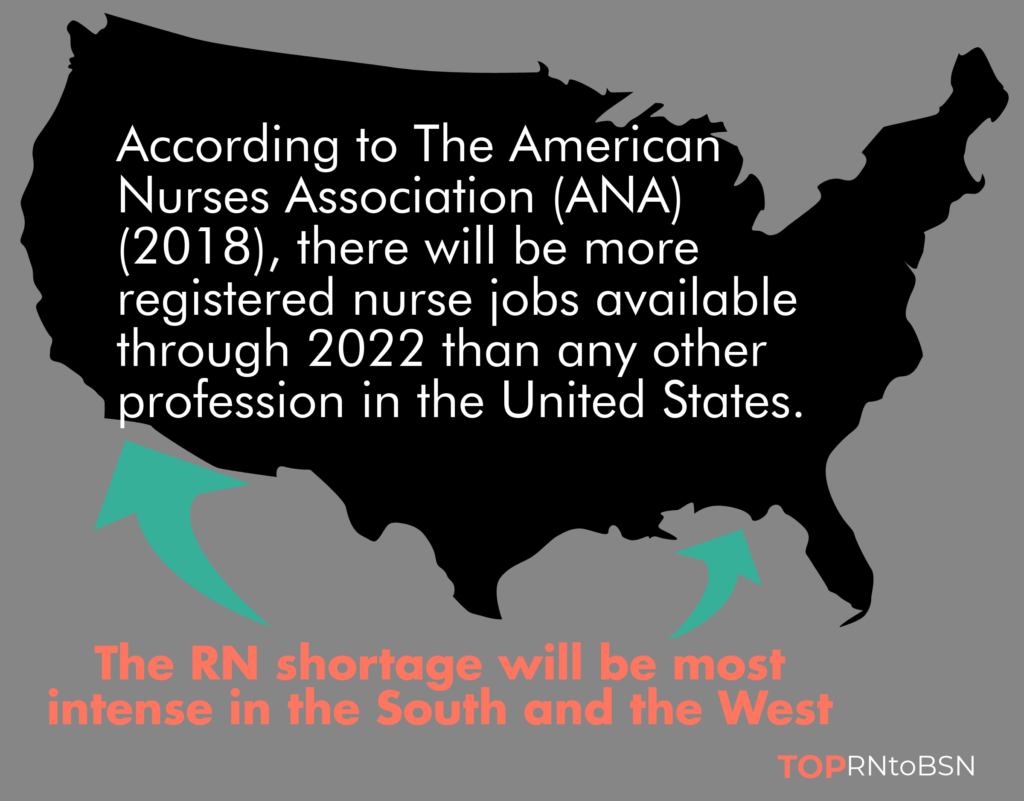
Nursing Shortage Solutions
Nursing Shortage Solutions consist of new degree programs, student financial assistance, more nurse educators, and travel nursing roles. Skeptics argue that the nursing shortage hype is nothing more than a nursing shortage myth.
Unfortunately, these disbelievers fail to see the truth about nursing shortage statistics. The reality is that the reemerging nursing shortage is a very real phenomenon, one that threatens American healthcare at its root. Shortages not only affect regular RNs but some of the most in-demand, high-paying nursing positions as well.
RN Shortage

Nursing Shortage Solutions
Many states have enacted Legislation to Address Nurse Staffing and Quality of Patient Care. For instance, California became the first state to recognize the need to monitor the average nurse-to-patient ratio in hospitals at a state level. In 1999, the state passed into law a state-mandated minimum nurse-to-patient ratio for acute care divisions in a hospital setting. To date, it is the only legislation of its kind.
However, the federal government had already taken the lead by enacting legislation (42CFR 482.23(b)) that mandates hospitals with Medicare certification to maintain adequate staffing levels to meet each patient’s needs as the need arises. These measures are part of combatting nurse burnout as well.
After the passage of the California legislation, a growing momentum began to seriously consider similar legislation across the country. To date, there are 14 states and the District of Columbia that have set forth official rules and regulations to address this ongoing, concerning issue.
- California
- Connecticut
- Illinois
- Massachusetts
- Minnesota
- Nevada
- New Jersey
- New York
- Ohio
- Oregon
- Rhode Island
- Texas
- Vermont
- Washington
- Washington, DC
Massachusetts and California are the only two states that have revised legislation that mandates nurse-patient ratios. Massachusetts varies from California in that the nurse-ratio requirements have some flexibility, whereas California’s legislation does not.
Other approaches to nursing shortage solutions include efforts to:
- Meet or exceed the average nurse-to-patient ratio in hospitals and other healthcare-related facilities
- Expand education facilities and programs as well as improve Medical Facilities Management Systems to address the staffing shortages in healthcare that create unnecessary patient risk
- Determine ways in which nurse staffing ratios and patient outcomes are optimized
- Attracting travel nurses for short-term relief
Nursing Studies
Confirming a Connection Between a Nursing Shortage and Patient CareSeveral years ago, The Lancet released a study that revealed that a simple 10% increase in nurses who held a bachelor’s degree could reduce patient mortality by as much as 7%.
The year before, the BMJ Quality & Safety Journal released a study. It revealed a direct correlation existed between a nursing staff’s high patient loads and the readmission rate at the medical facility.
At about the same time, the American Journal of Infection Control (AJIC) published a study. The AJIC paper confirmed a connection between high patient loads/nurse burnout to increased infections in surgical sites.
Health Services Research (HSR) issued a study that concluded that reduced patient-to-nurse ratios were associated with lowered mortality rates of patients.
Nursing shortage skeptics are finding it increasingly difficult to debate the effects of inadequate nursing staffing and nurse burnout. This growing body of research regarding the impact a nurse shortage has on the elderly, low-income populations, underserved urban communities, and patients from every walk of life.
Government and medical policymakers have more than enough evidence that confirms how positively impactful it would be to prepare an increasing amount of registered nurses who hold baccalaureate nursing degrees.
Nursing Staffing & Quality of Patient Care
As far back as 2007, the Agency for Healthcare Research & Quality (AHRQ), an agency within the Department of Health and Human Services, shared their conclusions from their study entitled Nursing Staffing & Quality of Patient Care.
- A shortage of nurses, combined with an increased patient load, creates a real challenge to quality patient care.
- Better-staffed nursing departments mitigate mortality rates in hospitals.
- Understaffed nursing departments negatively impacted a patient’s safety.
Check Out the Most Nurse-Friendly Hospitals in the US
What to Expect in 2020 and Beyond
According to the Bureau of Labor Statistics (BLS), the nursing profession is one of three industries that are anticipated to grow at a 9% pace through the year 2030. The nearly 450,000 additional nursing jobs to be needed are the result of the industry implementing net staffing regulations and the mass exodus of baby-boomer nurses set to retire by then.
States with Shortages
Additionally, the BLS continues to anticipate a nurse staffing imbalance through the year 2025. The nursing shortage article further advises that the lack of qualified licensed nurses will be most prevalent in the western and southern portions of the United States. The projected nursing shortage will adversely impact rural hospitals the most.
Imbalanced portions of the states of Florida, California, and Georgia have extensive aging populations, plus a reduced number of newly licensed nurses applying for jobs in these states. Together these two forces create critical nursing shortages that adversely impact patient care and nurse burnout.
What is Being Done to Solve the Nursing Shortage?
In response to the onslaught of nurse shortages over the past century, many states, the nursing/medical community, and the nurse education arena, have initiated significant efforts to discover how to deal with short-staffing in nursing.
The following examples are just a few of the nursing shortage solutions implemented over the past few years that meet the demand for nurses in the future. Nursing schools have begun to partner with private support channels in an effort to provide nursing shortage solutions that will increase the number of nurses admitted each year.
Highest Demand Areas for Nursing Shortage By State
Finanacial Incentives
Below are a few of the financial incentives that encourage qualified individuals to enter the profession.
Minnesota’s Veterans Administration Health Care
Minnesota’s Veterans Administration Health Care organization has partnered with the University of Minnesota by funding efforts for nurses who agree to teach after they have earned their degrees.
Johnson & Johnson (J&J)
Mega-conglomerate Johnson & Johnson (J&J) maintains an active campaign that encourages students to become professional nurses. J&J’s Campaign for Nursing’s Future offers a multimedia approach to polishing the image of the nursing industry.
American Association of Colleges of Nursing (AACN)
The American Association of Colleges of Nursing (AACN) contributes its resources to learning how to fix the nursing shortage. In 2010, the AACN launched an industry-wide centralized location for students to apply for admission to a nursing school.
The title of the AACN’s program is Nursing CAS. The fundamental purpose of the program is to make sure that all vacant spots in nursing education programs are filled to capacity, thus maximizing each program’s student capacity. During the calendar year 2018 along, the Nursing CAS identified nearly 50,000 vacant positions in the country’s nursing programs.
Robert Wood Johnson Foundation (RWJF)
The Robert Wood Johnson Foundation (RWJF) released a narrative regarding the very real need to focus on the expansion of educational facilities to accommodate the country’s ever-expanding demand for nursing professionals. The narrative was released in 2010 and was entitled Expanding America’s Capacity to Educate Nurses.
RWJF’s news release disclosed more than ten partnerships that are innovatively addressing shortages for nursing professionals and nurse educators. Industry experts advise it would be a great advantage to require newly licensed Registered Nurses to attain a Bachelor of Science in Nursing (BSN) degree ten years after obtaining the original nursing licensure. This approach will likely stack the deck full of nursing professionals who hold either an undergraduate nursing degree or a graduate nursing degree.
In addition to these large-scale efforts, many medical and healthcare facilities also implement programs that can modify nursing schedules to accommodate the challenging schedule of a professional nurse who is attending school at night or over the weekend. Additionally, vacant nursing positions in understaffed healthcare facilities have different incentives to encourage qualified nurses to apply.
Related:






